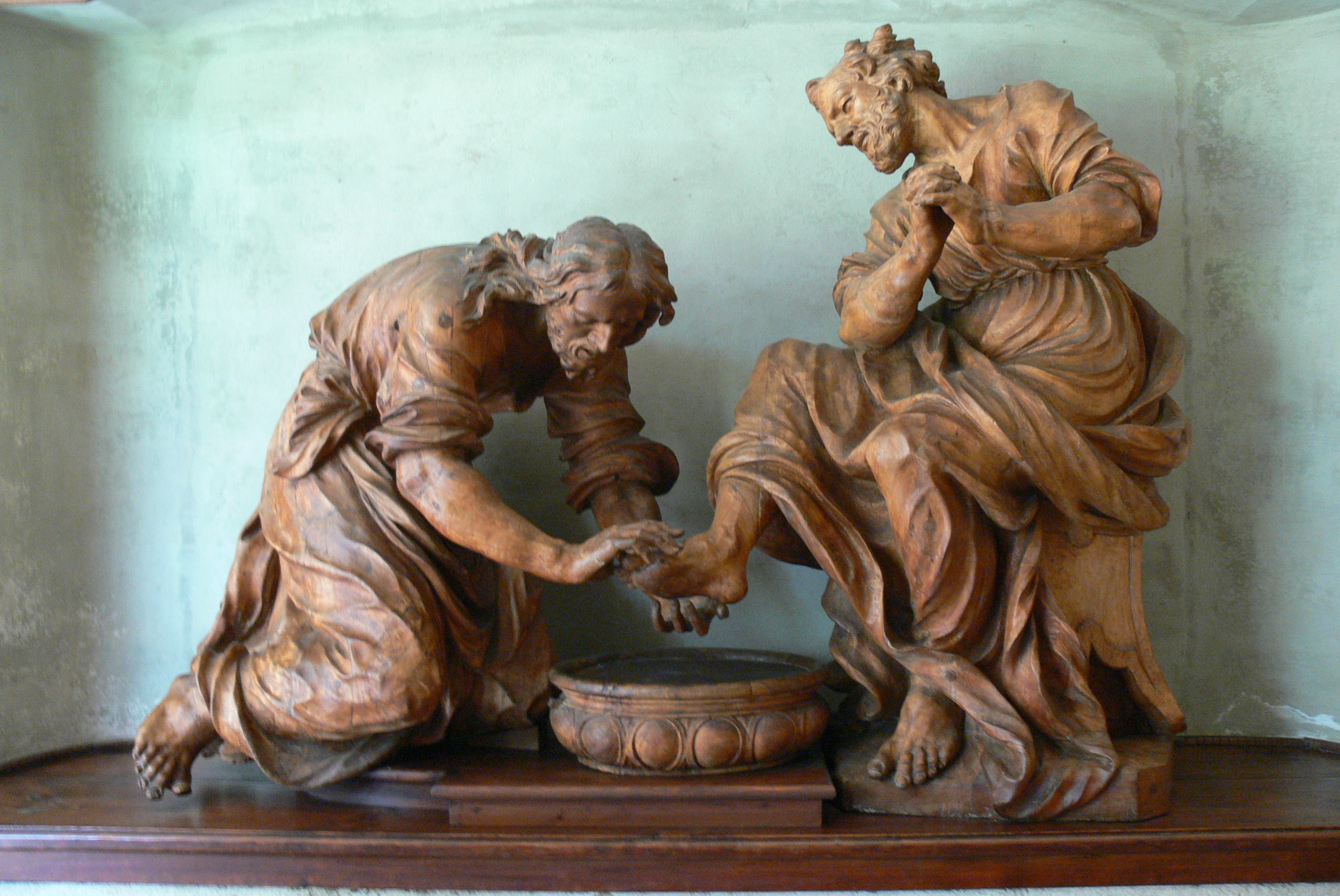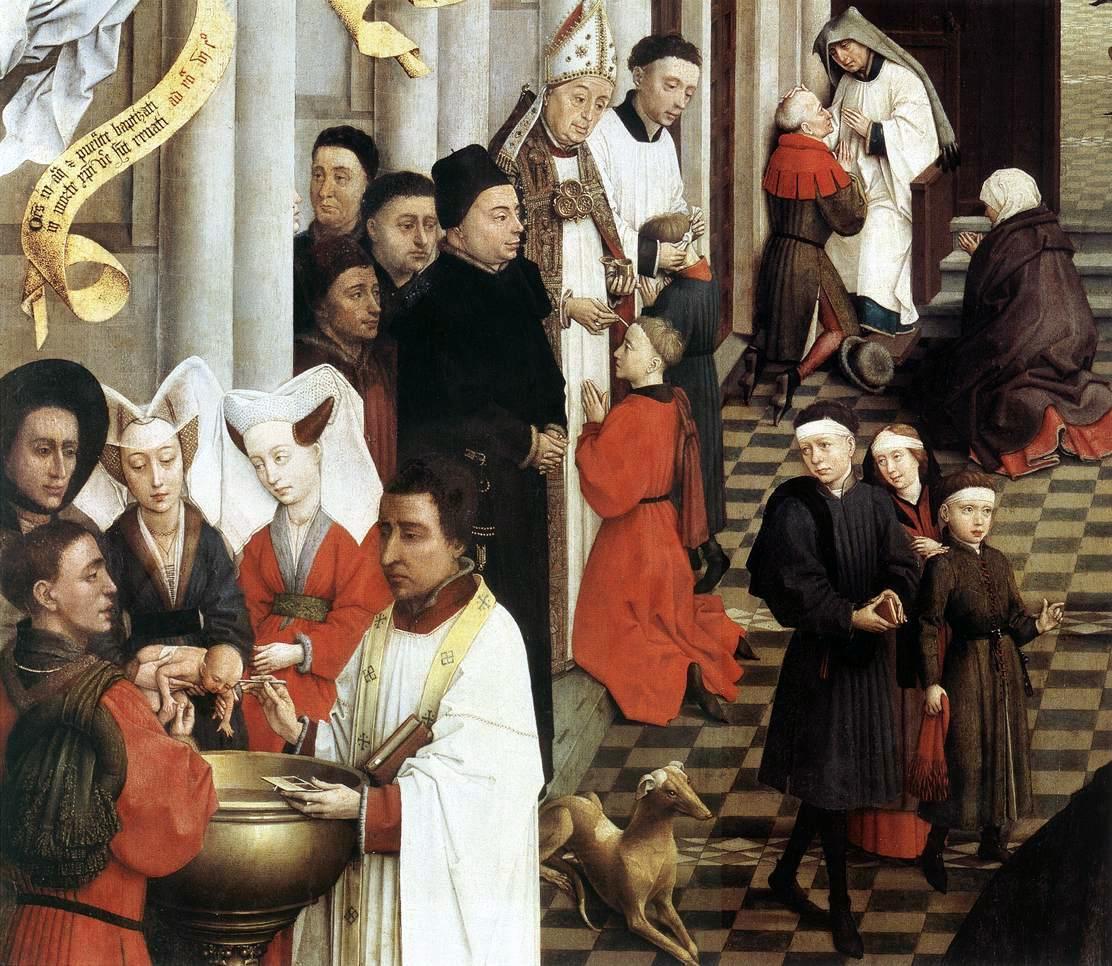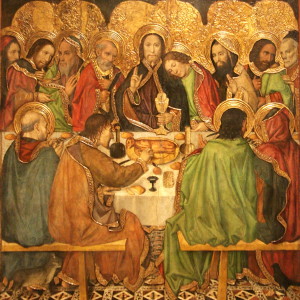 |
| Jaume Huguet, Last Supper (1470) |
Today is Holy Thursday, also known as Maundy Thursday. One of the very first posts that I wrote was about the significance of Maundy Thursday. It’s here, at the Last Supper, that we see: (1) the institution of the Eucharist, (2) the institution of the sacramental priesthood, and (3) references to Baptism and Confession. Sacramentally, then, it’s important and beautiful.
The Eucharist is straight-forward (Mt. 26:26-29; Mk. 14:22-25; Lk. 22:19-20; 1 Cor. 11:23-25). It’s also of obvious importance to the early Church: it’s one of relatively few events recorded (nearly verbatim) by St. Paul and the Synoptic Gospels. As Catholics, we believe that when Jesus said, “This is My Body,” and “This is My Blood of the Covenant,” that He meant “This is My Body,” and “This is My Blood of the Covenant,” and not some other thing, like “this is a symbol.” Suffice it to say that this language is prefigured in the Old Covenant (Exodus 24:8), and wasn’t symbolic then (as Hebrews 9:18-20 notes).
 |
| Giovanni Giuliani, Christ Washing the Feet of Peter (18th c.) |
But let’s talk a bit about Holy Orders. It’s not coincidental that the priesthood and Eucharist are established simultaneously. The Eucharistic Sacrifice, after all, requires priests: a priest, by definition, is one who offers sacrifice. But Christ does something interesting with this notion of priesthood in the washing of the feet (John 13:3-17). This appears to be a deliberate echo of the washing of the hands and feet done by the sacrificial priests of the Old Covenant (Exodus 30:19-21). This washing was to symbolize the priest’s unworthiness to approach the Lord, so it’s fitting that the washing of feet occurs at the same time that the Apostles are entrusted with the Eucharist (which they’re not worthy to approach). But notice what’s different: the Old Covenant focused on self-purification. The New Covenant is focused on sanctifying others. This is in keeping with the model of clerical governance that Christ imparts to St. Peter and the Apostles at this Last Supper (Luke 22:24-34).
 |
| Christ Washing the Feet of Peter (11th c.) |
And the washing of the feet doesn’t just represent the priesthood. It also represents Sacramental Confession. In John 13:6-10, Jesus and Peter have this dialogue:
He came to Simon Peter; and Peter said to him, “Lord, do you wash my feet?” Jesus answered him, “What I am doing you do not know now, but afterward you will understand.” Peter said to him, “You shall never wash my feet.” Jesus answered him, “If I do not wash you, you have no part in me.” Simon Peter said to him, “Lord, not my feet only but also my hands and my head!”Jesus said to him, “He who has bathed does not need to wash, except for his feet, but he is clean all over; and you are clean, but not every one of you.”
 |
| Rogier van der Weyden, Seven Sacraments Altarpiece(detail, right wing) (1450) |
Having established all of this, consider Christ’s dual commission. Immediately after instituting the Eucharist, He orders the Apostles: “do this in remembrance of me” (Lk. 22:19; 1 Cor. 11:24). That doesn’t mean “treat this as a symbol,” by the way. Once again, the Old Testament provides important context. The Old Covenant contained what’s called the memorial sacrifice or memorial offering (see, e.g., Leviticus 2:9). The sacrifice wasn’t a mere symbol: the memorial offering of grain actually was grain. And the memorial offering of our prayers (Acts 10:4) aren’t symbols of prayers, but actual prayers. Likewise, the memorial offering of Christ’s Body and Blood actually is Christ’s Body and Blood. But each of these memorial offerings also recalls something: in this case, we’re offering up Christ’s Body and Blood, while recalling His Death on Calvary.
So “do this in remembrance of me,” properly understood, is sacrificial language. The first Eucharist is offered by Christ, who is both the High Priest (Hebrews 9:11), and the willing Sacrificial Victim (1 Corinthians 5:7). Jesus makes this clear Himself in John 10:17-18: He is in control over everything, including Calvary. But what’s shocking is that He tells the Apostles to carry on His priestly role. To continue to offer the memorial offering of His Body and Blood.
Only slightly less shocking is the second commission, which comes at the end of the washing of the feet (John 13:12-17),
When he had washed their feet, and taken his garments, and resumed his place, he said to them, “Do you know what I have done to you? You call me Teacher and Lord; and you are right, for so I am. If I then, your Lord and Teacher, have washed your feet, you also ought to wash one another’s feet. For I have given you an example, that you also should do as I have done to you. Truly, truly, I say to you, a servant is not greater than his master; nor is he who is sent greater than he who sent him. If you know these things, blessed are you if you do them.”
 |
| Rogier van der Weyden, Seven Sacraments Altarpiece(detail, left wing) (1450) |
That’s the mandate (mandatum) that gives Maundy Thursday its name. Now, this doesn’t sound shocking at first, because it sounds like Jesus is just saying, “be humble.” And surely, that’s part of it. But remember what we established earlier: that the washing of feet is about the sacrificial priesthood, and about the forgiveness of sins. Jesus makes that last part really clear in John 13:6-11. He’s not calling Judas smelly. He’s saying Judas is still trapped in sin. So in that context, Jesus Christ is calling the Apostles not only to be humble, but to (a) forgive sins, and (b) pass on the gift of the priesthood. He’ll later empower the Apostles to carry out this command to forgive sins by imparting the Holy Spirit upon them (John 20:21-23). But too often, Christians read the washing of feet as simply a nice gesture, when Christ makes it clear that it’s so much more.
So tonight should be a true celebration of the Sacraments that Christ left us, and the beautiful manner in which they are, in God’s Providence, intertwined. Baptism, to wash us free from our sins. The Eucharist, partaking in the Body and Blood of Jesus Christ. Confession, to restore us to our Baptismal purity, and prepare us for the Eucharist. And Holy Orders, to carry on His priestly ministry, and to ensure that we should always have the Eucharist and Confession.

Joe,
I’ve been seeing some discussions around the web concluding that because of the explicit association of everything that happens during the Last Supper with the establishment of the priesthood the washing of the feet, or the mandatum, should be limited to 12 adult males, and that women and children should not take part.
What is your take on this?
God bless,
Tele